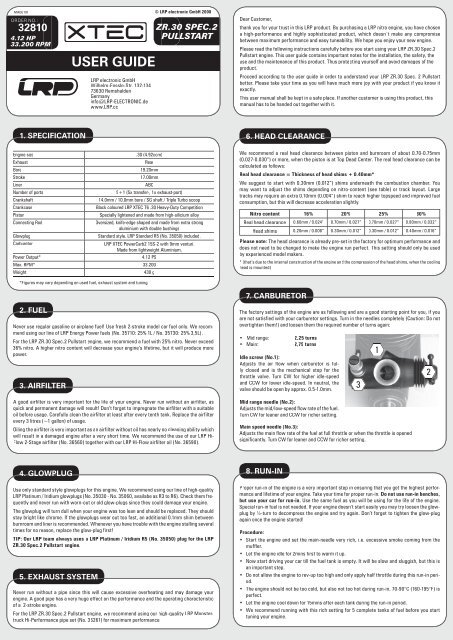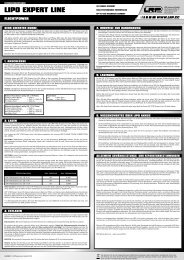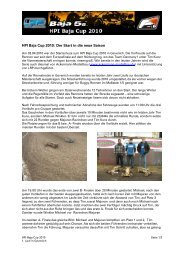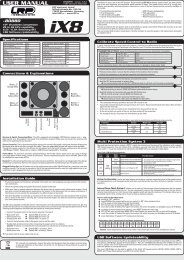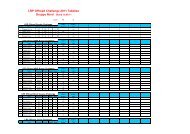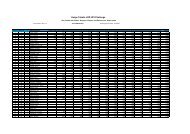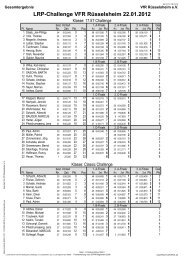You also want an ePaper? Increase the reach of your titles
YUMPU automatically turns print PDFs into web optimized ePapers that Google loves.
MA00191 © <strong>LRP</strong> electronic GmbH 2008<br />
ORDER NO.:<br />
32810<br />
4.12 HP<br />
33.200 RPM<br />
1. SPECIFICATION<br />
2. FUEL<br />
3. AIRFILTER<br />
4. GLOWPLUG<br />
5. EXHAUST SYSTEM<br />
<strong>USER</strong> <strong>GUIDE</strong><br />
<strong>LRP</strong> electronic GmbH<br />
Wilhelm-Enssle-Str. 132-134<br />
73630 Remshalden<br />
Germany<br />
info@<strong>LRP</strong>-ELECTRONIC.de<br />
www.<strong>LRP</strong>.cc<br />
Engine size .30 (4.92ccm)<br />
Exhaust Rear<br />
Bore 19.20mm<br />
Stroke 17.00mm<br />
Liner ABC<br />
Number of ports 5+1 (5x transfer-, 1x exhaust-port)<br />
ZR.30 SPEC.2<br />
PULLSTART<br />
Crankshaft 14.0mm / 10.0mm bore / SG shaft / Triple Turbo scoop<br />
Crankcase Black coloured <strong>LRP</strong> XTEC T6 .30 Heavy-Duty Competition<br />
Piston Specially lightened and made from high-silicium alloy<br />
Connecting Rod Oversized, knife-edge shaped and made from extra strong<br />
aluminium with double bushings<br />
Glowplug Standard style. <strong>LRP</strong> Standard R5 (No. 35050) included.<br />
Carburetor <strong>LRP</strong> XTEC PowerCarb2 15S-2 with 9mm venturi.<br />
Made from lightweight Aluminium.<br />
Power Output* 4.12 PS<br />
Max. RPM* 33.200<br />
Weight 430 g<br />
*Figures may vary depending on used fuel, exhaust system and tuning.<br />
Never use regular gasoline or airplane fuel! Use fresh 2-stroke model car fuel only. We recommend<br />
using our line of <strong>LRP</strong> Energy Power fuels (No. 35710: 25% 1L / No. 35730: 25% 3,5L).<br />
For the <strong>LRP</strong> ZR.30 Spec.2 Pullstart engine, we recommend a fuel with 25% nitro. Never exceed<br />
36% nitro. A higher nitro content will decrease your engine‘s lifetime, but it will produce more<br />
power.<br />
A good airfilter is very important for the life of your engine. Never run without an airfilter, as<br />
quick and permanent damage will result! Don’t forget to impregnate the airfilter with a suitable<br />
oil before usage. Carefully clean the airfilter at least after every tenth tank. Replace the airfilter<br />
every 3 litres (~1 gallon) of usage.<br />
Oiling the airfilter is very important as an airfilter without oil has nearly no cleaning ability which<br />
will result in a damaged engine after a very short time. We recommend the use of our <strong>LRP</strong> Hi-<br />
Flow 2-Stage airfilter (No. 36560) together with our <strong>LRP</strong> Hi-Flow airfilter oil (No. 36590).<br />
Use only standard style glowplugs for this engine. We recommend using our line of high-quality<br />
<strong>LRP</strong> Platinum / Iridium glowplugs (No. 35030 - No. 35060, availabe as R3 to R6). Check them frequently<br />
and never run with worn-out or old glow-plugs since they could damage your engine.<br />
The glowplug will turn dull when your engine was too lean and should be replaced. They should<br />
stay bright like chrome. If the glowplugs wear out too fast, an additional 0.1mm shim between<br />
burnroom and liner is recommended. Whenever you have trouble with the engine stalling several<br />
times for no reason, replace the glow-plug first!<br />
TIP: Our <strong>LRP</strong> team always uses a <strong>LRP</strong> Platinum / Iridium R5 (No. 35050) plug for the <strong>LRP</strong><br />
ZR.30 Spec.2 Pullstart engine.<br />
Never run without a pipe since this will cause excessive overheating and may damage your<br />
engine. A good pipe has a very huge effect on the performance and the operating characteristic<br />
of a 2-stroke engine.<br />
For the <strong>LRP</strong> ZR.30 Spec.2 Pullstart engine, we recommend using our high-quality <strong>LRP</strong> Monstertruck<br />
Hi-Performance pipe set (No. 36261) for maximum performance.<br />
Dear Customer,<br />
thank you for your trust in this <strong>LRP</strong> product. By purchasing a <strong>LRP</strong> nitro engine, you have chosen<br />
a high-performance and highly sophisticated product, which doesn´t make any compromise<br />
between maximum performance and easy tuneability. We hope you enjoy your new engine.<br />
Please read the following instructions carefully before you start using your <strong>LRP</strong> ZR.30 Spec.2<br />
Pullstart engine. This user guide contains important notes for the installation, the safety, the<br />
use and the maintenance of this product. Thus protecting yourself and avoid damages of the<br />
product.<br />
Proceed according to the user guide in order to understand your <strong>LRP</strong> ZR.30 Spec. 2 Pullstart<br />
better. Please take your time as you will have much more joy with your product if you know it<br />
exactly.<br />
This user manual shall be kept in a safe place. If another customer is using this product, this<br />
manual has to be handed out together with it.<br />
6. HEAD CLEARANCE<br />
We recommend a real head clearance between piston and burnroom of about 0.70-0.75mm<br />
(0.027-0.030“) or more, when the piston is at Top Dead Center. The real head clearance can be<br />
calculated as follows:<br />
Real head clearance = Thickness of head shims + 0.40mm*<br />
We suggest to start with 0.30mm (0.012“) shims underneath the combustion chamber. You<br />
may want to adjust the shims depending on nitro-content (see table) or track layout. Large<br />
tracks may require an extra 0.10mm (0.004“) shim to reach higher topspeed and improved fuel<br />
consumption, but this will decrease acceleration slightly.<br />
Nitro content 16% 20% 25% 30%<br />
Real head clearance 0.60mm / 0.024“ 0.70mm / 0.027“ 0.70mm / 0.027“ 0.80mm / 0.032“<br />
Head shims 0.20mm / 0.008“ 0.30mm / 0.012“ 0.30mm / 0.012“ 0.40mm / 0.016“<br />
Please note: The head clearance is already pre-set in the factory for optimum performance and<br />
does not need to be changed to make the engine run perfect. This setting should only be used<br />
by experienced model makers.<br />
* (that‘s due to the internal construction of the engine and the compression of the head shims, when the cooling<br />
head is mounted)<br />
7. CARBURETOR<br />
The factory settings of the engine are as following and are a good starting point for you, if you<br />
are not satisfied with your carburetor settings. Turn in the needles completely (Caution: Do not<br />
overtighten them!) and loosen them the required number of turns again:<br />
• Mid range: 2,25 turns<br />
• Main: 2,75 turns<br />
Idle screw (No.1):<br />
Adjusts the air flow when carburetor is fully<br />
closed and is the mechanical stop for the<br />
throttle valve. Turn CW for higher idle-speed<br />
and CCW for lower idle-speed. In neutral, the<br />
valve should be open by approx. 0.5-1.0mm.<br />
Mid range needle (No.2):<br />
Adjusts the mid/low-speed flow rate of the fuel.<br />
Turn CW for leaner and CCW for richer setting.<br />
Main speed needle (No.3):<br />
Adjusts the main flow rate of the fuel at full throttle or when the throttle is opened<br />
significantly. Turn CW for leaner and CCW for richer setting.<br />
8. RUN-IN<br />
Proper run-in of the engine is a very important step in ensuring that you get the highest performance<br />
and lifetime of your engine. Take your time for proper run-in. Do not use run-in benches,<br />
but use your car for run-in. Use the same fuel as you will be using for the life of the engine.<br />
Special run-in fuel is not needed. If your engine doesn’t start easily you may try loosen the glowplug<br />
by ½-turn to decompress the engine and try again. Don’t forget to tighten the glow-plug<br />
again once the engine started!<br />
Procedure:<br />
• Start the engine and set the main-needle very rich, i.e. excessive smoke coming from the<br />
muffler.<br />
• Let the engine idle for 2mins first to warm it up.<br />
• Now start driving your car till the fuel tank is empty. It will be slow and sluggish, but this is<br />
an important step.<br />
• Do not allow the engine to rev-up too high and only apply half throttle during this run-in period.<br />
• The engine should not be too cold, but also not too hot during run-in. 70-90°C (160-195°F) is<br />
perfect.<br />
• Let the engine cool down for 15mins after each tank during the run-in period.<br />
• We recommend running with this rich setting for 5 complete tanks of fuel before you start<br />
tuning your engine.<br />
3<br />
1<br />
2
9. TUNING<br />
It never hurts to have the mixture too rich, but NEVER let the mixture get too lean. Always tune<br />
from rich to lean. If in doubt, richen it up first! Never try to tune a cold engine, run 3-5 minutes to<br />
get the engine up to running temperature before doing any adjustments! Otherwise the engine<br />
is not warmed up properly and the tuning is not correct.<br />
Basic tuning procedure is as follows:<br />
1. Set the engine’s idle speed up slightly higher than normal.<br />
2. Start tuning your engine with the settings too rich.<br />
3. Always tune main-speed needle (top-end) first.<br />
4. Tune mid-range needle next.<br />
5. Reset idle speed screw.<br />
Procedure:<br />
1. Set the idle speed so your engine doesn’t stall (slightly higher then normal).<br />
2. Go to the track with the main-needle set too rich. There should be heavy smoke coming from<br />
the muffler now.<br />
3. Tune the engine by leaning the main-needle 1/8 turn at a time (turn clockwise).<br />
- Your goal will be that the engine will just reach maximum RPM on the straightaway.<br />
- Open the main-needle again by an 1/8 turn (turn counter-clockwise) when you have reached<br />
that point. This should be the perfect setting for the main-needle. Temperature between 110-<br />
130°C (230-265°F).<br />
- If the main-needle is set too lean, the engine will overheat and will not accelerate smoothly.<br />
If this happens, immediately stop the engine and richen the main-needle (counterclockwise)<br />
1/4 turn.<br />
4. Adjust the mid-range needle now. Run 3 full laps, stop the car near you and let it idle for<br />
5secs. Then push full throttle. The engine should have slightly richened up (idle rpm gets<br />
lower), but still accelerate quickly. If it died before the 5secs, check the following:<br />
- If the rpm constantly decreases and finally the engine stops, the mid-range needle is too<br />
rich.<br />
- If the idle-speed increases during idle, the mid-range needle is too lean.<br />
5. You may have to re-adjust the idle-speed now. If it idles too high, the clutch may not release<br />
completely and you will lose „snap“ off the corners. If it idles too low, it may stall at the start,<br />
or at the end of the straightaway when you release the throttle.<br />
Ways to measure the engine temperature:<br />
• Temperature gauge method (recommended): Take the temperature reading quickly after driving.<br />
Place the gauge directly over the engine and let the sensor point at glow plug.<br />
• Spittle method: Put some spittle on the engine’s head directly after driving. The spittle should<br />
just slowly boil off (2-3secs). It should not dance around as if it were on a hot griddle, nor<br />
should it lay there and steam.<br />
10. AFTER RUN<br />
Use special „after-run oil“ to keep the engine in good shape after you have finished your day.<br />
After-run oil helps for an easy start the next time you drive and protects your internals against<br />
rust. Use only „after-run oil“ specially formulated for R/C engines. Do not use silicone shock oil<br />
or similar as they will seriously harm your engine. We recommend to use our <strong>LRP</strong> After-Run oil<br />
(No. 37910), which you should use regularly after running your engine.<br />
Procedure:<br />
First let the tank run completely empty at idle until it runs out of fuel (try re-starting it several<br />
times). Next put a few drops of <strong>LRP</strong> After-Run oil down the open carburetor and a few drops<br />
down the glow plug hole. Spin the engine over several times so the oil spreads evenly inside<br />
the engine.<br />
11. MAINTENANCE<br />
Treat your engine with care and check it frequently. Due to the extremely high RPM this engine<br />
produces, any fault can cause serious damage. All moving parts inside the engine are subject<br />
to wear, you must know if a piston/liner/conrod has worn out and if they need to be replaced. If<br />
you replace one part, please check if everything else is still in good shape at the same time. If<br />
you only change one part and other parts are in bad shape, there’s the possibility that there will<br />
be a new failure soon!<br />
Some important matters:<br />
• Clean the outside of the engine properly before you open it. Any dust or dirt which gets into<br />
the engine could make considerable damage.<br />
• Check the conrod frequently. If you want to replace the conrod, be sure the big end of your<br />
crankshaft is still round and at a good size. If not, also replace the crankshaft.<br />
• When you start putting your engine back together, make sure that each part is totally clean<br />
before installation and please use some oil (after-run is suited well) to lubricate everything.<br />
• Be careful that each part has its correct direction, especially piston/liner/conrod. Please also<br />
check the explosion drawing. The lubrication hole in the conrod should be facing to the front<br />
(direction to the carburetor).<br />
• Before you install the combustion chamber, please doublecheck that you installed all head<br />
shims.<br />
• Use a hex wrench to install the screws. When you start to feel resistance, stop turning the<br />
screw. Repeat this for each screw, use the star-technique to tighten all the screws completely.<br />
Do not overtighten them!<br />
12. TROUBLE SHOOTING <strong>GUIDE</strong><br />
PROBLEM REASON SOLUTION<br />
Engine does not start Glow plug defective - Replace eplace glow plug<br />
Glow plug does not work - Check the condition of the glow plug<br />
properly<br />
- Check the glow plug igniter<br />
Engine is set too rich<br />
- Check carburetor settings and repeat the tuning<br />
(too much fuel, flooded) procedure<br />
- Unscrew the glow plug completely and spin over<br />
the engine several times<br />
Engine is too lean<br />
- Check carburetor setting and repeat the tuning<br />
(too little fuel, does not start) procedure<br />
Engine doesn’t suck in the fuel - Check the fuel line for possible damage<br />
- Check the carburetor setting<br />
Engine stops after a Glow plug defective - Replace eplace glow plug<br />
short time after glow<br />
plug igniter has been<br />
disconnected<br />
Bad fuel<br />
Bad carburetor setting<br />
- Replace eplace fuel with fresh and correct type of fuel<br />
- Check carburetor settings and repeat the tuning<br />
procedure<br />
Dirt in fuel line or carburetor - Clean fuel line and clean and check the carburetor<br />
Fuel line damaged - Replace eplace fuel line<br />
Loose glow plug or cooling head - Tighten the glow plug or the screws of the<br />
cooling head<br />
Air filter old and/or dirty - Clean lean or replace air filter<br />
Performance<br />
Engine is set too lean - Check the carburetor setting and repeat the<br />
decreases after<br />
tuning procedure<br />
reaching operating<br />
temperature or engine<br />
stalls from time to time<br />
Glow plug defective or wrong<br />
type<br />
Engine runs too hot<br />
- Replace the glow plug by a correct type<br />
- Run-in un-in process is not completed<br />
Shims under combustion<br />
chamber wrong<br />
- Check number of shims<br />
Engine still keeps Bad carburetor setting - Open mid-range needle ¼ turn at a time and<br />
running at high RPM<br />
re-adjust idle-speed<br />
for a moment when<br />
- Set idle speed lower<br />
you release the throttle<br />
Wrong glow plug type (too hot) - Use glow plug with higher number (e.g. go from<br />
5 to 6)<br />
Shims under combustion<br />
chamber wrong<br />
- Check number of shims<br />
REPAIR PROCEDURES /<br />
LIMITED WARRANTY<br />
All products from <strong>LRP</strong> electronic GmbH (hereinafter called “<strong>LRP</strong>”) are manufactured according<br />
to the highest quality standards. <strong>LRP</strong> guarantees this product to be free from defects in materials<br />
or workmanship for 90 days (non-european countris only) from the original date of purchase<br />
verified by sales receipt. This limited warranty doesn’t cover defects, which are a result of<br />
misuse, improper maintenance, outside interference or mechanical damage. This applies among<br />
other things on:<br />
• Engine disassembly by customer<br />
• Any modification of the engine done by the customer<br />
• Rust inside the engine<br />
• Dust or dirt inside the engine<br />
• Damaged engine due to glow plug failure<br />
• Overheating<br />
• Scratches inside the engine caused by dirt or dust<br />
• Water in fuel<br />
• Wrong break-in procedure<br />
• Damaged piston due to piston stop devices<br />
• Damaged cylinder exhaust port due to piston stop devices<br />
• Breakages at high rpm without engine load<br />
To eliminate all other possibilities or improper handling, first check all other components in your<br />
model and the trouble shooting guide, if available, before you send in this product for repair.<br />
If products are sent in for repair, which do operate perfectly, we have to charge a service fee<br />
according to our pricelist.<br />
With sending in this product, the customer has to advise <strong>LRP</strong> if the product should be repaired<br />
in either case. If there is neither a warranty nor guarantee claim, the inspection of the product<br />
and the repairs, if necessary, in either case will be charged with a fee at the customers expense<br />
according to our price list. A proof of purchase including date of purchase needs to be included.<br />
Otherwise, no warranty can be granted. For quick repair- and return service, add your address<br />
and detailed description of the malfunction.<br />
If <strong>LRP</strong> no longer manufactures a returned defective product and we are unable to service it,<br />
we shall provide you with a product that has at least the same value from one of the successor<br />
series.<br />
The specifications like weight, size and others should be seen as guide values. Due to ongoing<br />
technical improvements, which are done in the interest of the product, <strong>LRP</strong> does not take any<br />
responsibility for the accuracy of these specs.<br />
<strong>LRP</strong>-Distributor-Service:<br />
• Package your product carefully and include sales receipt and detailed description of malfunction.<br />
• Send parcel to your national <strong>LRP</strong> distributor.<br />
• Distributor repairs or exchanges the product.<br />
• Shipment back to you usually by COD (cash on delivery), but this is subject to your national<br />
<strong>LRP</strong> distributor‘s general policy.
MA00192 © <strong>LRP</strong> electronic GmbH 2008<br />
1. EXPLOSIONSZEICHNUNG / EXPLOSION DRAWING<br />
���������<br />
��������������������������<br />
�����<br />
�����<br />
����������<br />
����������������������������������<br />
�����������������������<br />
�������������������<br />
2. ERSATZTEILE / SPARE PARTS<br />
3. TUNINGTEILE / OPTION PARTS<br />
����������������������<br />
���������������������<br />
BEST. NR. Artikelbezeichnung<br />
BEST. NR. Artikelbezeichnung<br />
ORDER NO. spare part description<br />
ORDER NO. spare part description<br />
38550 ZR.30 Spec.2 - Crankcase 38574 ZR.30 Spec.2 - Wrist Pin & Clips<br />
38552 ZR.30 Spec.2 - Cylinder Head incl. Screws 38575 ZR.30 Spec.2 - Crankshaft<br />
38554 ZR.30 Spec.2 - 9mm Slide Carburetor 38576 ZR.30 Spec.2 - Ball Bearing Front (7x19x6mm)<br />
38556 ZR.30 Spec.2 - Pullstarter Front Parts (Linkage) 38577 ZR.30 Spec.2 - Ball Bearing Rear (14x25.4x6mm)<br />
38557 ZR.30 Spec.2 - Pullstarter Rear Parts (Backplate) 38590 ZR.30 Spec.2 - Headshims (4 pcs.)<br />
38570 ZR.30 Spec.2 - Burn Room 38591 ZR.30 Spec.2 - Various Parts Bag<br />
38572 ZR.30 Spec.2 - 5+1 Port Piston & Sleeve Set 38592 ZR.30 Spec.2 - O-Ring Set<br />
38573 ZR.30 Spec.2 - Conrod 38491 ZR 30 Spec.2 - Pullstart One-Way Bearing<br />
BEST. NR. Artikelbezeichnung<br />
BEST. NR. Artikelbezeichnung<br />
ORDER NO. spare part description<br />
ORDER NO. spare part description<br />
37505 <strong>LRP</strong> Competition Clutch Set .30 Off-Road 35030 <strong>LRP</strong> Platinum / Iridium Glowplug Std. R3 Med/Hot<br />
36560 <strong>LRP</strong> Highflow 2-stage airfilter 35040 <strong>LRP</strong> Platinum / Iridium Glowplug Std. R4 Med<br />
36590 <strong>LRP</strong> Highflow airfilter oil 35050 <strong>LRP</strong> Platinum / Iridium Glowplug Std. R5 Med/Cold<br />
37910 <strong>LRP</strong> After-Run oil 35060 <strong>LRP</strong> Platinum / Iridium Glowplug Std. R6 Cold<br />
79920 LiPo Receiver Battery 2200 | 7.4V - Straight 36261 <strong>LRP</strong> Monstertruck Hi-Performance pipe set<br />
79925 LiPo Receiver Battery 2300 | 7.4V - Hump 65857 HiVolt+ RX-Pack 1400 - Hump<br />
45000 LiPo RX-Regulator 6V/5A 65858 HiVolt+ RX-Pack 1400 - Straight<br />
�����<br />
�����<br />
�����<br />
�����<br />
�����<br />
�����<br />
�����<br />
�����<br />
�����<br />
�����<br />
�����<br />
�����<br />
�����<br />
�����<br />
�����<br />
�����<br />
�����<br />
�����


